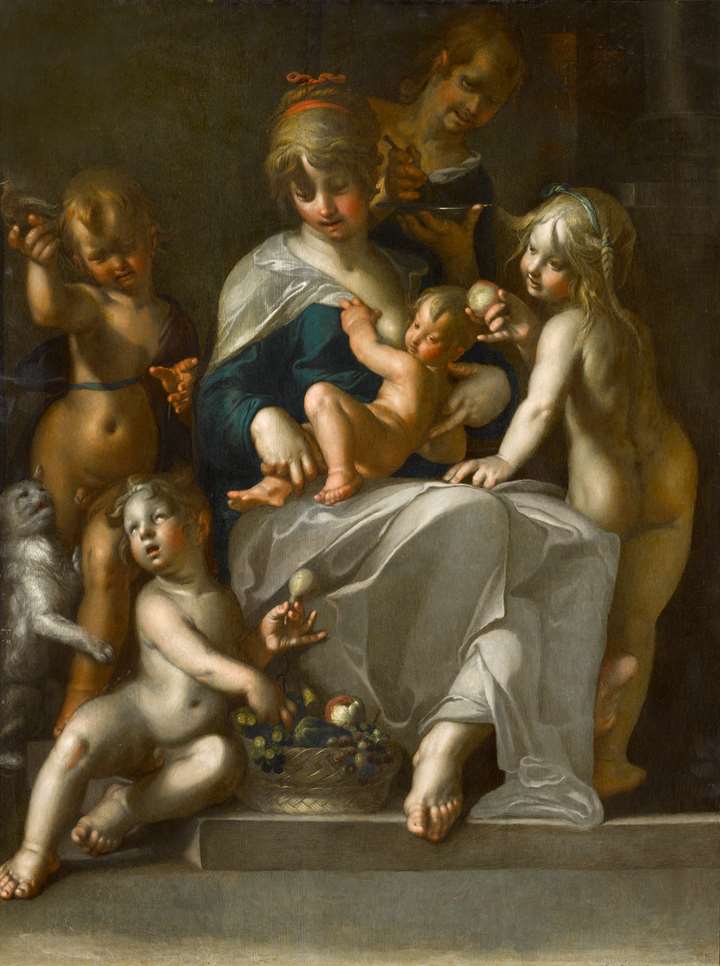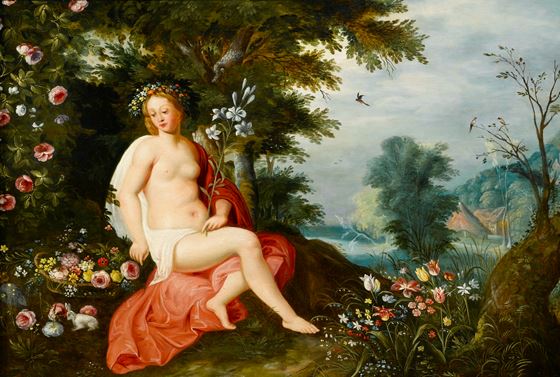Description & Technical information
A voluptuous Flora, the ancient Italian goddess of flowers is draped in luxurious cream and scarlet robes and contrasts harmoniously with the blue tones of the landscape behind her. Set in a secluded wooded clearing imaginatively filled with an astonishing variety of wild flowers and with an intricate aquamarine backdrop, the classical subject matter blends seamlessly with Flemish realism underlined by the two rustic huts glimpsed in the middle ground of the far right of the composition.
Flora is carefully framed by two groupings of flowers. At her left side, a myriad of luscious pink roses, narcissi, buttercups, violas, primroses and poppies predominate while on her other side, tulips and bluebells mingle together. Nestled in the lush grass next to a wicker basket overflowing with blooms of every description are two rabbits, one white and another darker one. Throughout the ages the rabbit has been symbolic of fecundity and has consequently been transmuted into a symbol for lust. In this context, it perhaps alludes to the licentious nature of Flora’s Roman festival, the Floralia which was held in April and included theatrical entertainment involving naked actresses and prostitutes. Both the ancient authors Ovid and Lucretius describe the goddess in their works: Lucretius, in his encyclopaedic explanation for the origins of nature, De Rerum Natura, describes how Flora followed in the footsteps of Zephyr (the east wind) in the spring time, strewing his way with blossoms.¹ Ovid, from whom Sandro Botticelli (1445-1510) later drew inspiration for his Primavera (Uffizi Gallery, Florence), tells of Flora fleeing from Zephyr: ‘When he at length embraced her, flowers spilled from her lips and she was transformed into Flora’.²
Jan Brueghel II’s skill at depicting flowers in all their natural complexity is exemplified in another of his flower paintings which hangs in the Hermitage, St. Petersburg. Holy Family Framed with Flowers displays some of the same flowers, notably the tulips and roses, and narcissi as in Flora Seated in a Wooded Landscape. The muted yet lustrous colour palette enhanced by flecks of white and silver brushwork in the Hermitage painting is also a distinctive feature of the present work.
Breughel II trained in the studio of his father and subsequently journeyed to Milan to meet his father’s patron Cardinal Federico Borromeo. Having travelled to Sicily with Anthony van Dyck (1599-1641) in 1624, he joined the Antwerp Guild of St. Luke the following year. As well as working with Govaerts, he also collaborated with Peter Paul Rubens (1577-1640) and Hendrick van Balen (1575-1632) and indeed the figure of Flora appears to be influenced by van Balen’s work.
Govaerts’ paintings typically incorporate mythological or biblical subjects within a mannerist, tricolour landscape framed by repoussoir trees. Figures, and in this case flowers, were often added by other artists.
Brueghel II and Abraham Govaerts frequently collaborated on works, particularly those with mythological subject matter. Dr. Klaus Ertz confirms in a letter dated 7 February, 2007 ‘that the painting was created by the Flemish painters Abraham Govaerts, who arranged the landscape and Jan Brueghel the Younger, who painted the flowers.’ The latter attribution is perfectly in keeping with the tradition of flower painting established by Brueghel II’s father, Jan Brueghel I (1568-1625).
¹ Lucretius, De Rerum Natura V.736-739.
² Ovid, Fasti V.193-214.
Period: 1600-1750, 17th century
Origin: Belgium
Medium: Oil on panel
Dimensions: 44 x 64 cm (17³/₈ x 25¹/₄ inches)
Provenance: with Newhouse Galleries, New York, as Hendrick van Balen and Jan Breughel, the elder;
Private Collection, by whom sold, Christie's, New York, 3 October 2006, as Circle of Jan van Kessel.
Categories: Paintings, Drawings & Prints

Discover the gallery
Sphinx Fine Art
Old Master & Russian Paintings
More Works From This Gallery

Sphinx Fine Art
A View of the the Haarlemmerhout, Haarlem
Gerrit Adriaensz. Berckheyde (Haarlem, 1638 - Haarlem, 1698)
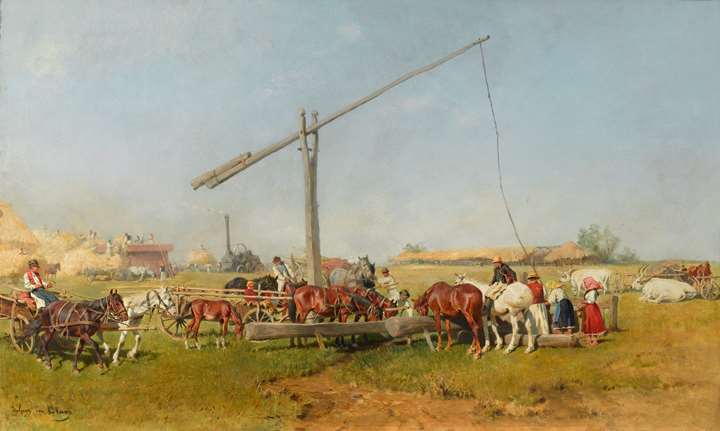
Sphinx Fine Art
Taking the Horses to Water
Julius von Blaas (Austrian, 1845 - 1922)
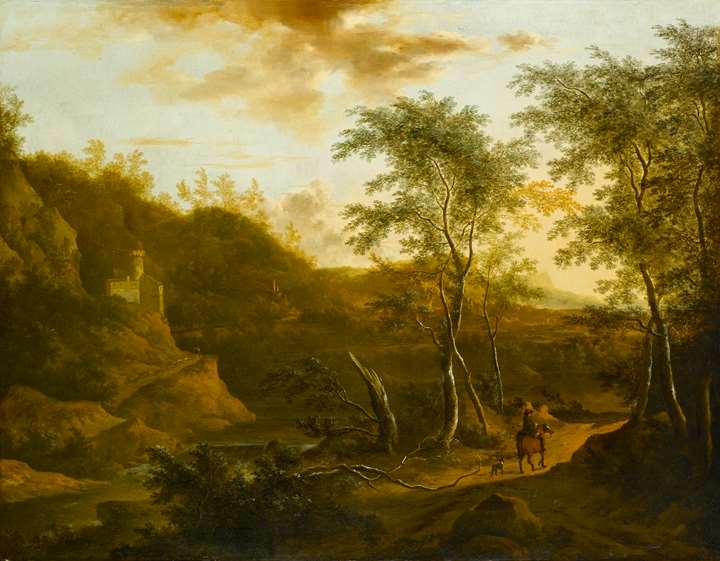
Sphinx Fine Art
A Wooded River Landscape with a Traveller on a Track
Frederik de Moucheron (Emden, Germany, 1633 - Amsterdam, 1686)
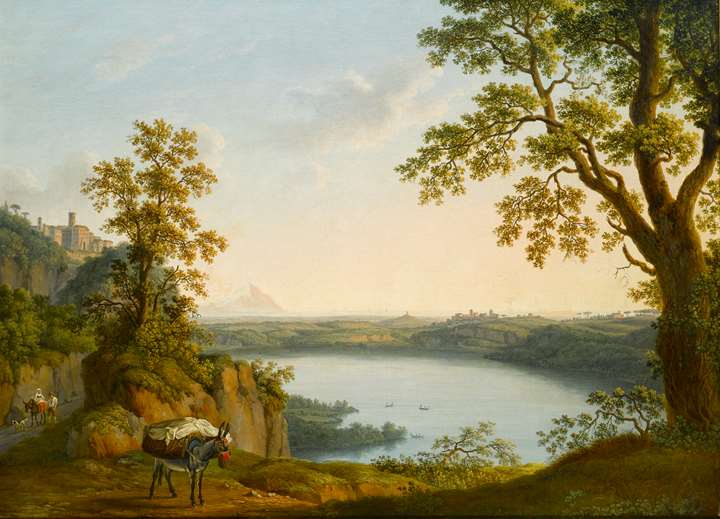
Sphinx Fine Art
Lake Nemi from the North, with the Town of Nemi and the Town of Genzano beyond, with a Donkey and Travellers on a Path in the Foreground
Jacob Philipp Hackert (Prenzlau, 1737 - Florenz, 1807)

Sphinx Fine Art
Mounted Cossacks & Mounted Cossacks Discovering a Landscape
Ludwig Gedlek (Austrian, 1847 - 1904)
